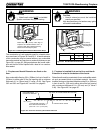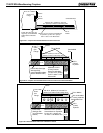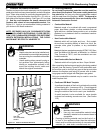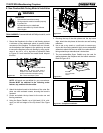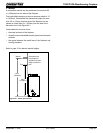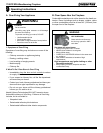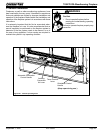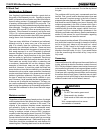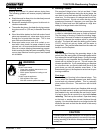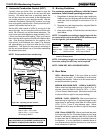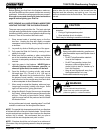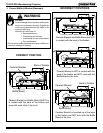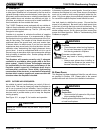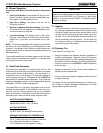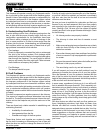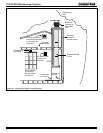
September 1, 2008
433-1390G
Page 47
7100FP EPA Woodburning Fireplace
R
Storing Wood
Splitting wood before it is stored reduces drying time.
The following guideline will ensure properly seasoned
wood:
a. Stack the wood to allow air to circulate freely around
and through the woodpile.
b. Elevate the woodpile off the ground to allow air cir-
culation underneath.
c. The smaller the pieces, the faster the drying process.
Any piece over 6 in. (152 mm) in diameter should be
split.
d. Wood should be stacked so that both ends of each
piece are exposed to air, since more drying occurs
through the cut ends than the sides. This is true
even with wood that has been split.
e. Store wood under cover, such as in a shed, or cov-
ered with a tarp, plastic, tar paper, sheets of scrap
plywood, etc., as uncovered wood can absorb water
from rain or snow, delaying the seasoning process.
Avoid covering the sides and ends completely. Doing
so may trap moisture from the ground and impede
air circulation.
E. Burning Process
Fire requires 3 things to burn: fuel, air and heat. If heat
is robbed from the fireplace during the drying stage, the
new load of wood has reduced the chances for a good
clean burn. For this reason, it is always best to burn dry,
seasoned firewood. We do not advise burning unsea-
soned wood, however if it happens, you must open the
Slide Air Control and burn the fireplace at a high burn
setting for a longer time to start it burning.
Kindling or 1st stage:
It helps to know a little about the actual process of burning
in order to understand what goes on inside a fireplace.
The first stage of burning is called the kindling stage.
In this stage, the wood is heated to a temperature high
enough to evaporate the moisture which is present in
all wood. The wood will reach the boiling point of water
(212°F) and will not get any hotter until the water is
evaporated. This process takes heat from the coals and
tends to cool the fireplace.
2nd stage:
The next stage of burning, the secondary stage, is the
period when the wood gives off flammable gases which
burn above the fuel with bright flames. During this stage
of burning it is very important that the flames be main-
tained and not allowed to go out. This will ensure the
cleanest possible fire. If you are adjusting your fireplace
for a low burn rate, you should close down the air to the
point where you can still maintain some flame. If the
flames tend to go out, the fireplace is set too low for your
burning conditions.
Final stage:
The final stage of burning is the charcoal stage. This
occurs when the flammable gases have been mostly
burned and only charcoal remains. This is a naturally
clean portion of the burn. The coals burn with hot blue
flames.
It is very important to reload your fireplace while enough
lively hot coals remain in order to provide the amount of
heat needed to dry and rekindle the next load of wood.
It is best to open the air control for a short while before
reloading. This livens up the coalbed. Open door slowly
so that ash or smoke does not exit fireplace through
opening. You should also break up any large chunks and
distribute the coals so that the new wood is laid evenly
on hot coals.
Fireplace operation does require air. Do not take air from
other fuel burning appliances which can result in improper
venting (smoking) or air dilution. Always provide adequate
makeup air.
CAUTION
WARNING
Fire Risk.
Do NOT store wood:
• Closer than required clearances to com-
bustibles to appliance
• Within space required for loading or ash
removal.
Do NOT operate appliance:
• With appliance door open.
• With ash removal system door open.



